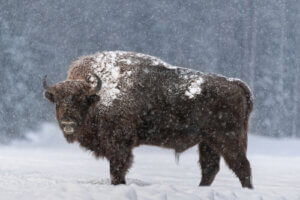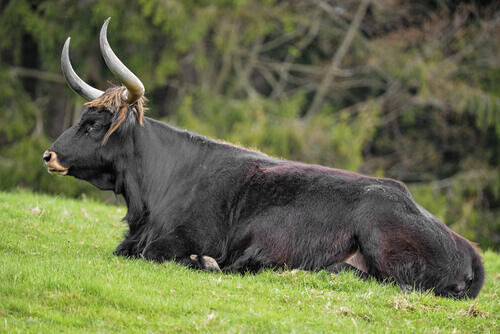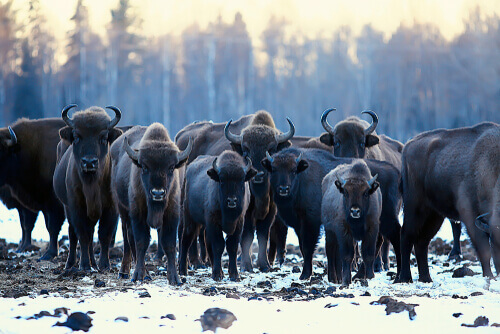The Characteristics of the Eurasian Auroch


Written and verified by the biologist Miguel Mata Gallego
The Eurasian auroch (Bos primigenius primigenius) is the ancestor of domestic cows and bulls. They roamed freely across these plains until its disappearance in 1627. In today’s article, you’ll learn about the impressive characteristics of this huge mammal.
The taxonomic debate – Eurasian auroch or bison?
Up until the 17th century, most European scientists and naturalists placed aurochs and bison in the same category. Also, they claimed it was the common ancestor of modern cattle.
However, in the 18th century, some naturalists began to claim that these animals were in fact two different species:
- Aurochs, the wild ancestors of bulls
- Bison, the current close relatives
As you can see, there were two schools of thought in this regard. One that claimed they were a single bovine species and the one that claimed they were two separate ones. Everything started to change after several fossil discoveries in the 19th century.
Their review led to the realization that Eurasian aurochs and bison are clearly different. In fact, some naturalists, such as Bojanus, changed their minds and accepted the theory of the two species as valid.

Characteristics of the Eurasian aurochs
The Eurasian aurochs resembled a sort of huge bull, only with wilder characteristics. Its weight could easily reach a ton and a specimen could be about 7 feet tall — slightly shorter than the American aurochs. Thus, although similar, many things differentiate them from modern cattle:
- They had a considerably larger and heavier skull that supported their horns; it could grow as long as three feet
- In addition, their legs were longer, more flexible, and muscular
- Finally, they had a rather athletic musculature, especially in the neck area of males
Behavior and habitat
Researchers believe Eurasian aurochs lived in herds dominated by one or two males. They established a social hierarchy through fights. These mainly occurred during the mating season — as with most mammals.
In regard to their habitat, they likely frequented forest clearings and river banks beside the aforementioned meadows. Actually, the loss of this habitat was the main factor in its extinction (more on this below).
The natural history of the Eurasian auroch
The expansion of aurochs through Eurasia
The climate was colder during the Pliocene period. Thus, there were many herbaceous meadows in Eurasia. This gave a great adaptive advantage to animals such as bovids, already accustomed to cold weather thanks to their fur and condition as herbivores. This is probably why the aurochs spread throughout Eurasia diversifying into various subspecies, some of which would be domesticated.
Domestication – the origin of our current livestock
According to several studies, during the Neolithic revolution, two domestications happened in different parts of the world.
- In the Indian subcontinent, giving rise to the current zebu (Bos primigenius indicus)
- In Europe, giving rise to domestic cows and bulls (Bos taurus indicus)
Extinction
Like most of the Pleistocene fauna, the aurochs lost their habitat. These animals had fewer places to live due to human expansion of crops and hunting.
As you can see, their population was significantly reduced to only a few hundred specimens in the Middle Ages. The last ones inhabited the forests of Poland, where they were a hunting trophy exclusive to kings. According to records, the last specimen, a female, died in the Jaktorow Forest in 1627.
The “genetic resurrection” of the Eurasian auroch
In recent years, people have proposed various programs to try to obtain specimens as similar as possible to the original auroch.
Scientists do this by crossing domestic breeds with ancestral characteristics, some of which are already in decline. Some of these breeds are the Sayagüesa, the Limia and Pajuna, the Maremmana, and the Maronesa cattle.
The genetic material of aurochs comes from fossil remains, and scientists expect to obtain the most similar specimen to date by 2025.
“Currently we’re in the fourth generation of crosses and the forecast is we’ll have the final specimen by 2025 — this is an approximate calculation. It won’t be 100% like the original auroch but very similar.”
-Ronald Goderie, Director of the Taurus Foundation-

However, one of the things that’ll be hard to recover is the character and behavior of the ancestral auroch, affected by centuries of domestication.
Thanks for reading.
The Eurasian auroch (Bos primigenius primigenius) is the ancestor of domestic cows and bulls. They roamed freely across these plains until its disappearance in 1627. In today’s article, you’ll learn about the impressive characteristics of this huge mammal.
The taxonomic debate – Eurasian auroch or bison?
Up until the 17th century, most European scientists and naturalists placed aurochs and bison in the same category. Also, they claimed it was the common ancestor of modern cattle.
However, in the 18th century, some naturalists began to claim that these animals were in fact two different species:
- Aurochs, the wild ancestors of bulls
- Bison, the current close relatives
As you can see, there were two schools of thought in this regard. One that claimed they were a single bovine species and the one that claimed they were two separate ones. Everything started to change after several fossil discoveries in the 19th century.
Their review led to the realization that Eurasian aurochs and bison are clearly different. In fact, some naturalists, such as Bojanus, changed their minds and accepted the theory of the two species as valid.

Characteristics of the Eurasian aurochs
The Eurasian aurochs resembled a sort of huge bull, only with wilder characteristics. Its weight could easily reach a ton and a specimen could be about 7 feet tall — slightly shorter than the American aurochs. Thus, although similar, many things differentiate them from modern cattle:
- They had a considerably larger and heavier skull that supported their horns; it could grow as long as three feet
- In addition, their legs were longer, more flexible, and muscular
- Finally, they had a rather athletic musculature, especially in the neck area of males
Behavior and habitat
Researchers believe Eurasian aurochs lived in herds dominated by one or two males. They established a social hierarchy through fights. These mainly occurred during the mating season — as with most mammals.
In regard to their habitat, they likely frequented forest clearings and river banks beside the aforementioned meadows. Actually, the loss of this habitat was the main factor in its extinction (more on this below).
The natural history of the Eurasian auroch
The expansion of aurochs through Eurasia
The climate was colder during the Pliocene period. Thus, there were many herbaceous meadows in Eurasia. This gave a great adaptive advantage to animals such as bovids, already accustomed to cold weather thanks to their fur and condition as herbivores. This is probably why the aurochs spread throughout Eurasia diversifying into various subspecies, some of which would be domesticated.
Domestication – the origin of our current livestock
According to several studies, during the Neolithic revolution, two domestications happened in different parts of the world.
- In the Indian subcontinent, giving rise to the current zebu (Bos primigenius indicus)
- In Europe, giving rise to domestic cows and bulls (Bos taurus indicus)
Extinction
Like most of the Pleistocene fauna, the aurochs lost their habitat. These animals had fewer places to live due to human expansion of crops and hunting.
As you can see, their population was significantly reduced to only a few hundred specimens in the Middle Ages. The last ones inhabited the forests of Poland, where they were a hunting trophy exclusive to kings. According to records, the last specimen, a female, died in the Jaktorow Forest in 1627.
The “genetic resurrection” of the Eurasian auroch
In recent years, people have proposed various programs to try to obtain specimens as similar as possible to the original auroch.
Scientists do this by crossing domestic breeds with ancestral characteristics, some of which are already in decline. Some of these breeds are the Sayagüesa, the Limia and Pajuna, the Maremmana, and the Maronesa cattle.
The genetic material of aurochs comes from fossil remains, and scientists expect to obtain the most similar specimen to date by 2025.
“Currently we’re in the fourth generation of crosses and the forecast is we’ll have the final specimen by 2025 — this is an approximate calculation. It won’t be 100% like the original auroch but very similar.”
-Ronald Goderie, Director of the Taurus Foundation-

However, one of the things that’ll be hard to recover is the character and behavior of the ancestral auroch, affected by centuries of domestication.
Thanks for reading.
This text is provided for informational purposes only and does not replace consultation with a professional. If in doubt, consult your specialist.








